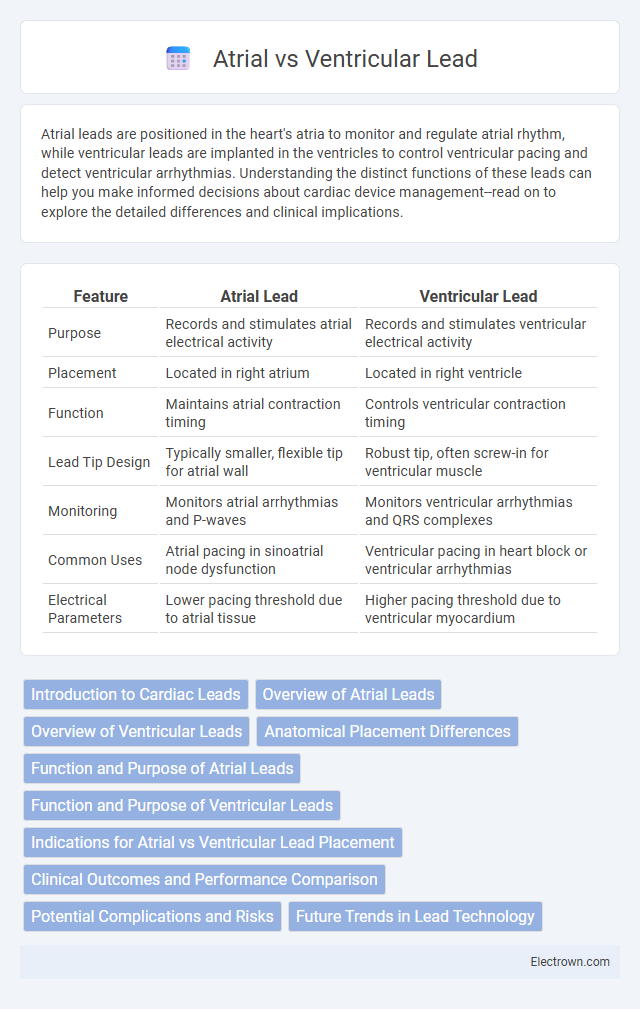Atrial leads are positioned in the heart's atria to monitor and regulate atrial rhythm, while ventricular leads are implanted in the ventricles to control ventricular pacing and detect ventricular arrhythmias. Understanding the distinct functions of these leads can help you make informed decisions about cardiac device management--read on to explore the detailed differences and clinical implications.
Table of Comparison
| Feature | Atrial Lead | Ventricular Lead |
|---|---|---|
| Purpose | Records and stimulates atrial electrical activity | Records and stimulates ventricular electrical activity |
| Placement | Located in right atrium | Located in right ventricle |
| Function | Maintains atrial contraction timing | Controls ventricular contraction timing |
| Lead Tip Design | Typically smaller, flexible tip for atrial wall | Robust tip, often screw-in for ventricular muscle |
| Monitoring | Monitors atrial arrhythmias and P-waves | Monitors ventricular arrhythmias and QRS complexes |
| Common Uses | Atrial pacing in sinoatrial node dysfunction | Ventricular pacing in heart block or ventricular arrhythmias |
| Electrical Parameters | Lower pacing threshold due to atrial tissue | Higher pacing threshold due to ventricular myocardium |
Introduction to Cardiac Leads
Cardiac leads are specialized wires used in pacemakers and defibrillators to deliver electrical impulses to the heart muscle. Atrial leads are positioned in the atrium to regulate the upper chambers' rhythm, while ventricular leads are placed in the ventricles to control the lower chambers' contractions. The precise placement and functionality of these leads are crucial for effective cardiac pacing and synchronization.
Overview of Atrial Leads
Atrial leads are specialized cardiac device components designed to sense and stimulate electrical activity specifically within the atria of the heart, supporting paced atrial contractions to maintain proper rhythm. Commonly used in dual-chamber pacemakers, these leads help manage arrhythmias such as atrial fibrillation by delivering precise electrical impulses. Their placement in the right atrial appendage or septum allows for optimal detection and pacing efficacy in synchronization with ventricular activity.
Overview of Ventricular Leads
Ventricular leads are specialized components of cardiac pacemakers designed to deliver electrical impulses directly to the ventricles, ensuring effective heart contractions when natural pacing fails. These leads are typically positioned in the right ventricle and are crucial for maintaining synchronous ventricular rhythm in patients with bradycardia or heart block. Your cardiac device relies on the precise function of ventricular leads to restore and regulate proper heartbeat intervals, enhancing overall cardiovascular health.
Anatomical Placement Differences
Atrial leads are positioned within the right atrium to monitor and regulate atrial electrical activity, while ventricular leads are placed in the right ventricle to manage ventricular contractions. The anatomical placement difference affects pacing thresholds and sensing capabilities due to variations in myocardial tissue thickness and conduction pathways. Your choice of lead type depends on the specific cardiac condition requiring atrial or ventricular pacing support.
Function and Purpose of Atrial Leads
Atrial leads are designed to sense and pace the atria, maintaining proper atrial rhythm and coordinating atrioventricular conduction. They detect atrial depolarization and deliver electrical impulses to correct arrhythmias such as atrial fibrillation or sinus node dysfunction. These leads play a crucial role in dual-chamber pacemakers, optimizing cardiac output by ensuring synchronized atrial and ventricular contractions.
Function and Purpose of Ventricular Leads
Ventricular leads deliver electrical impulses directly to the ventricles, ensuring effective pacing and maintaining proper heart rhythm in conditions like bradycardia or heart block. These leads play a critical role in synchronizing ventricular contractions, improving cardiac output and preventing arrhythmias. Your cardiac device relies on ventricular leads for precise stimulation, critical in managing heart failure and other ventricular dysfunctions.
Indications for Atrial vs Ventricular Lead Placement
Atrial lead placement is primarily indicated for patients requiring atrial pacing to maintain atrioventricular synchrony, such as those with sinus node dysfunction or atrioventricular block with intact atrial activity. Ventricular lead placement is crucial in cases of ventricular bradycardia, complete heart block, or ventricular arrhythmias, providing reliable ventricular pacing support. Selection depends on the underlying cardiac rhythm disorder and the need for single or dual-chamber pacing to optimize hemodynamic performance.
Clinical Outcomes and Performance Comparison
Atrial leads demonstrate superior sensing and pacing thresholds in patients with sinus rhythm, enhancing atrial rhythm management, while ventricular leads provide reliable capture and sensing critical for ventricular arrhythmia control. Clinical outcomes reveal that dual-chamber pacing with both atrial and ventricular leads reduces the incidence of atrial fibrillation and improves hemodynamic stability compared to ventricular-only pacing. Performance comparison highlights that advancements in lead design, including steroid-eluting tips, have minimized lead-related complications and improved long-term stability in both atrial and ventricular lead systems.
Potential Complications and Risks
Atrial leads carry risks such as lead dislodgement, atrial perforation, and increased risk of atrial arrhythmias due to their placement in the thinner atrial myocardium. Ventricular leads, positioned in the thicker ventricular muscle, present complications including higher thresholds for pacing, risk of cardiac perforation, and potential for ventricular arrhythmias or pacing-induced cardiomyopathy. Both lead types may cause infection, lead fracture, or insulation failure, necessitating careful monitoring and management for optimal device function.
Future Trends in Lead Technology
Atrial and ventricular lead technology is evolving with the integration of advanced materials and miniaturized sensors to enhance biocompatibility and signal accuracy. Future trends emphasize wireless lead designs and leadless pacing systems that reduce infection risks and improve patient comfort. Innovations in AI-driven diagnostics and adaptive pacing algorithms promise personalized cardiac care by optimizing lead performance in real-time.
Atrial vs Ventricular Lead Infographic

 electrown.com
electrown.com